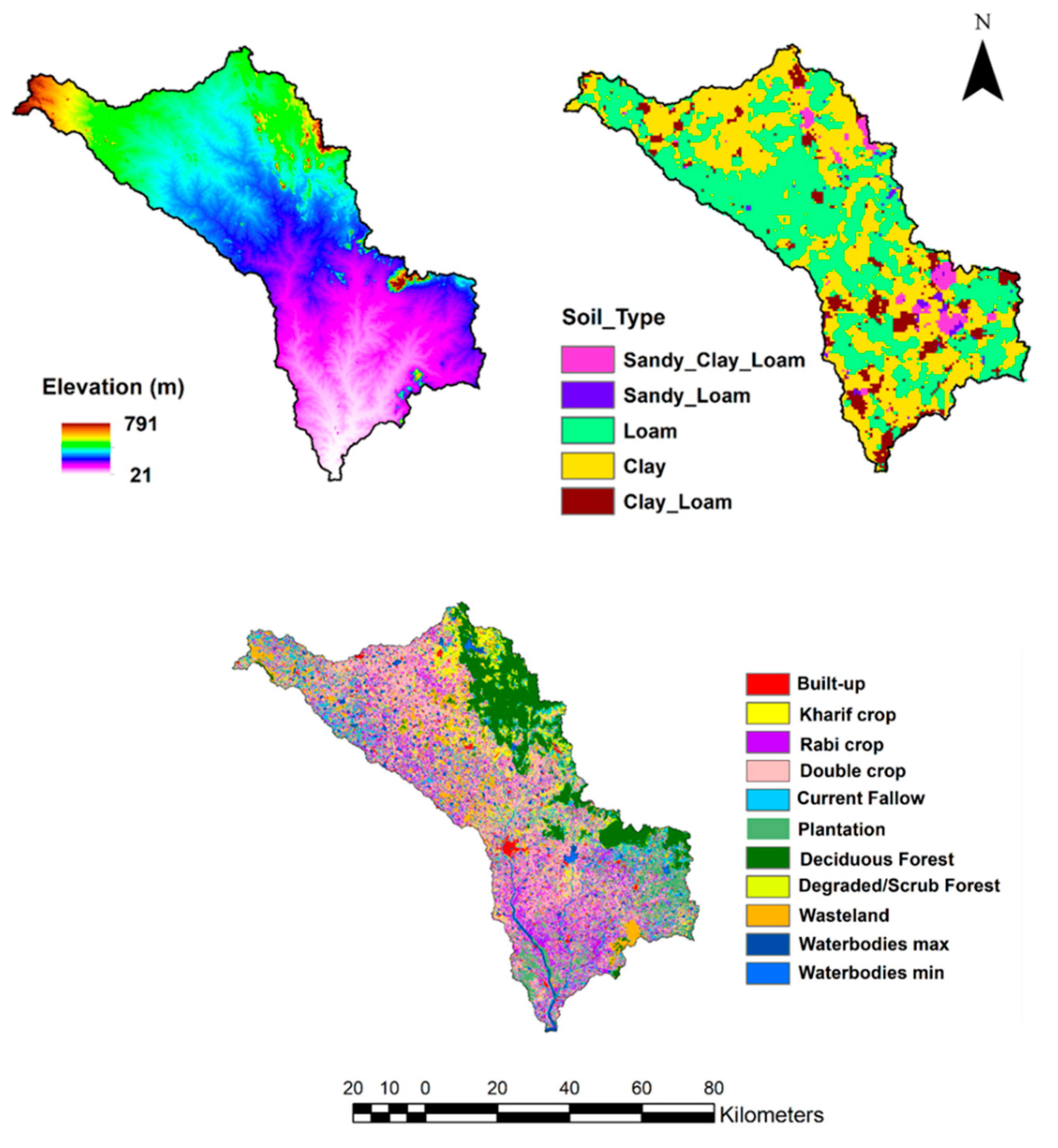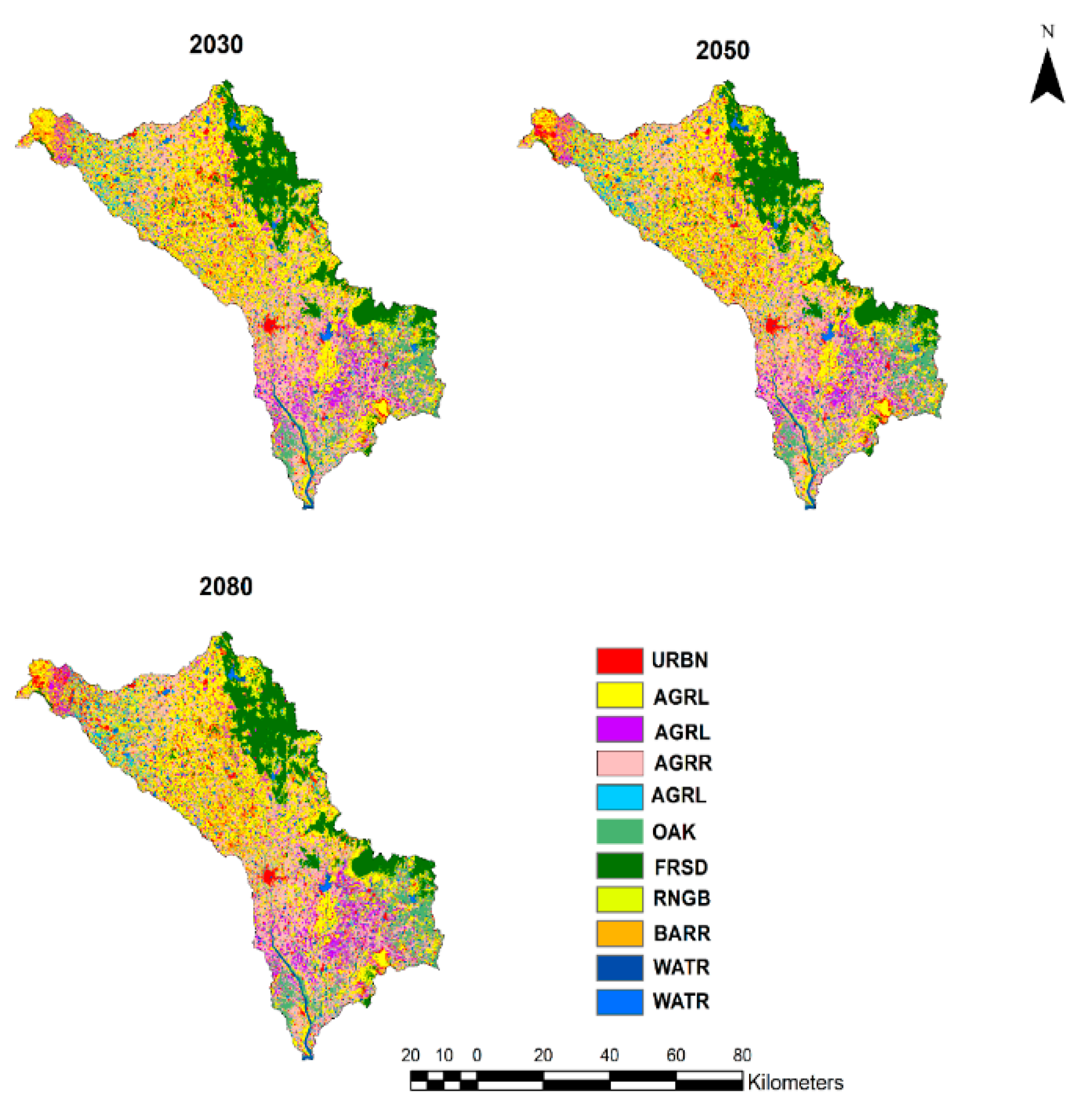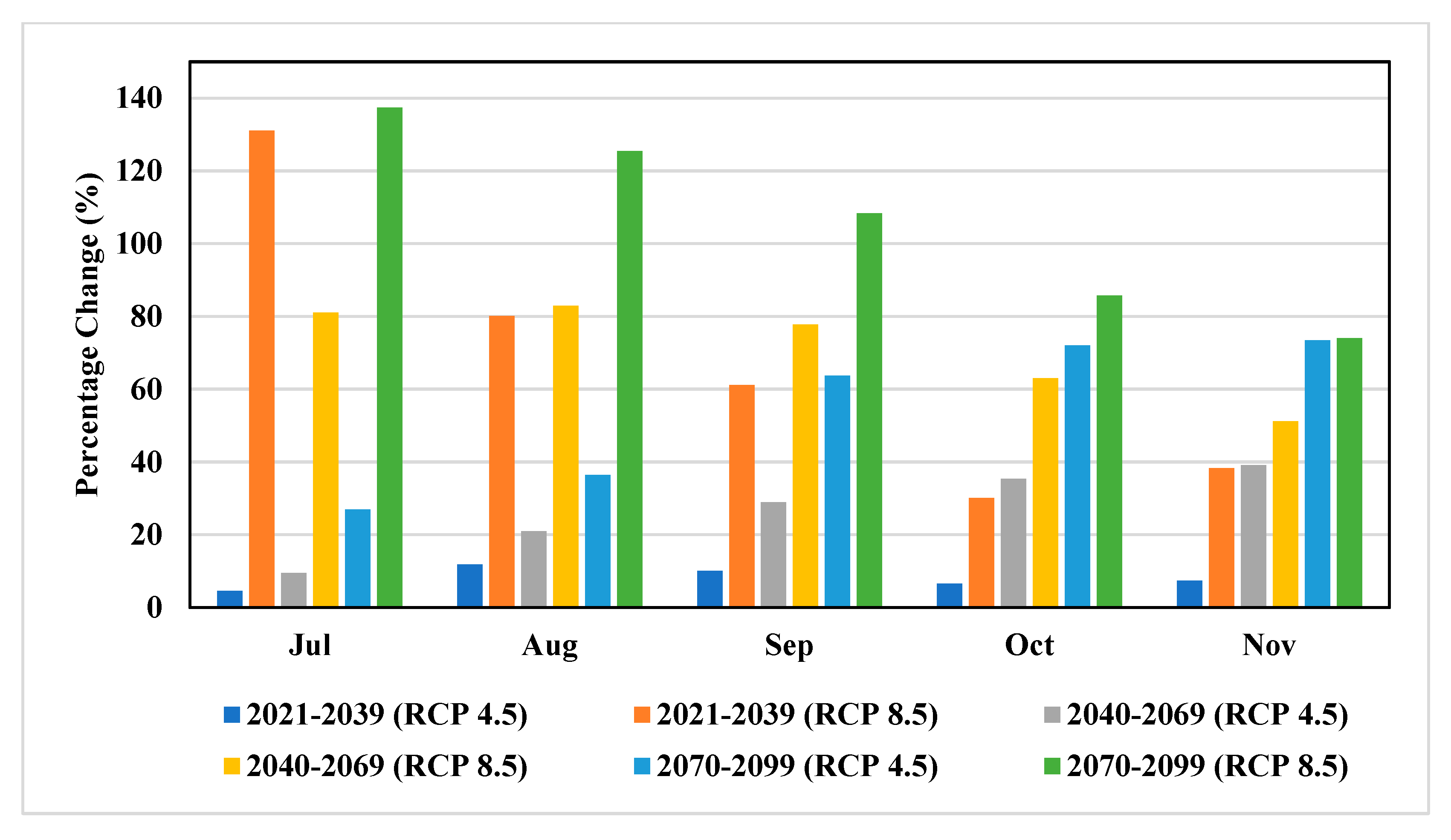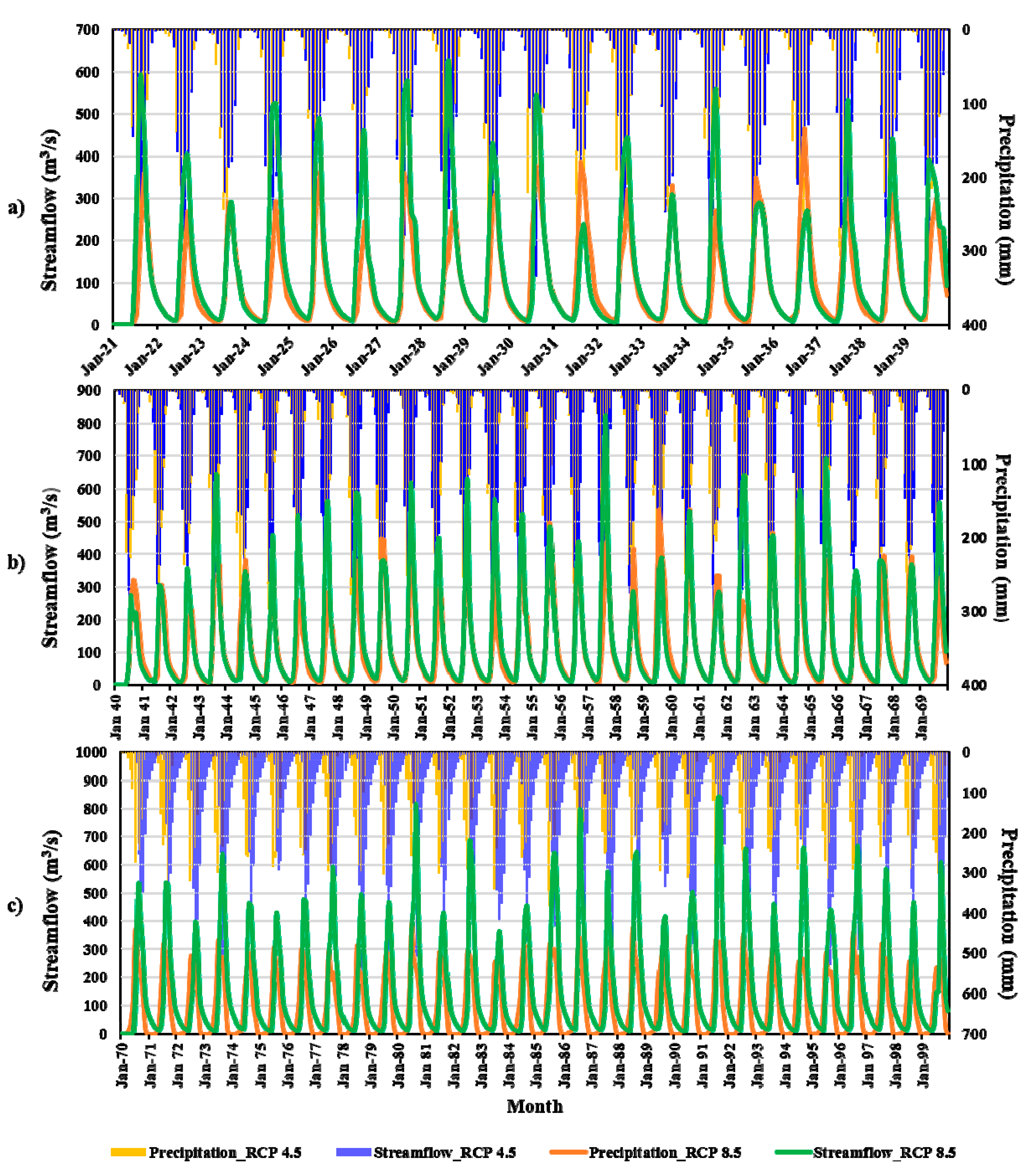Predicting the Effects of Land Use Land Cover and Climate Change on Munneru River Basin Using CA-Markov and Soil and Water Assessment Tool
Abstract
:1. Introduction
2. Study Area
3. Data Used
4. Methodology
4.1. Prediction of LULC Using CA-Markov Model
4.2. Hydrological Modelling
5. Results and Discussions
5.1. Changes in LULC
5.2. Analysis of Streamflow Using SWAT
5.3. Impact of Climate Change on Streamflow and Water Balance Components
5.4. Combined Impact of LULC and Climate Change on Streamflow and Water Balance Components
6. Conclusions
Author Contributions
Funding
Institutional Review Board Statement
Informed Consent Statement
Data Availability Statement
Acknowledgments
Conflicts of Interest
References
- Chanapathi, T.; Thatikonda, S.; Keesara, V.R.; Ponguru, N.S. Assessment of water resources and crop yield under future climate scenarios: A case study in a Warangal district of Telangana, India. J. Earth Syst. Sci. 2020, 129, 1–17. [Google Scholar] [CrossRef]
- Sharafati, A.; Pezeshki, E. A strategy to assess the uncertainty of a climate change impact on extreme hydrological events in the semi-arid Dehbar catchment in Iran. Theor. Appl. Climatol. 2020, 139, 389–402. [Google Scholar] [CrossRef]
- Sridhar, V.; Wedin, D.A. Hydrological behavior of Grasslands of the Sandhills: Water and Energy Balance Assessment from Measurements, Treatments and Modeling. Ecohydrology 2009, 2, 195–212. [Google Scholar] [CrossRef]
- Loukika, K.N.; Keesara, V.R.; Sridhar, V. Analysis of Land Use and Land Cover Using Machine Learning Algorithms on Google Earth Engine over the Munneru River Basin, India. Sustainability 2021, 13, 13758. [Google Scholar] [CrossRef]
- Sayasane, R.; Kawasaki, A.; Shrestha, S.; Takamatsu, M. Assessment of potential impacts of climate and land use changes on stream flow: A case study of the Nam Xong watershed in Lao PDR. J. Water Clim. Chang. 2016, 7, 184–197. [Google Scholar] [CrossRef]
- Sujatha, E.R.; Sridhar, V. Spatial Prediction of Erosion Risk of a small mountainous watershed using RUSLE: A case-study of the Palar sub-watershed in Kodaikanal, South India. Water 2018, 10, 1608. [Google Scholar] [CrossRef] [Green Version]
- Gong, X.; Bian, J.; Wang, Y.; Jia, Z.; Wan, H. Evaluating and Predicting the Effects of Land Use Changes on Water Quality Using SWAT and CA–Markov Models. Water Resour. Manag. 2019, 33, 4923–4938. [Google Scholar] [CrossRef]
- Sridhar, V.; Kang, H.; Ali, S.A. Human-induced alterations to land use and climate and their responses on hydrology and water management in the Mekong River basin. Water. 2019, 11, 1307. [Google Scholar] [CrossRef] [Green Version]
- Shang, X.; Jiang, X.; Jia, R.; Wei, C. Land use and climate change effects on surface runoff variations in the upper Heihe River basin. Water 2019, 11, 344. [Google Scholar] [CrossRef] [Green Version]
- Setti, S.; Maheswaran, R.; Radha, D.; Sridhar, V.; Barik, K.K.; Narasimham, M.L. Attribution of hydrologic changes in a tropical river basin to climate and land use change: A case study from India. ASCE J. Hydrol. Eng. 2020, 258, 5020015. [Google Scholar] [CrossRef]
- Dosdogru, F.; Kalin, L.; Wang, R.; Yen, H. Potential impacts of land use/cover and climate changes on ecologically relevant flows. J. Hydrol. 2020, 584, 124654. [Google Scholar] [CrossRef]
- Haghighi, A.T.; Darabi, H.; Shahedi, K.; Solaimani, K.; Kløve, B. A scenario-based approach for assessing the hydrological impacts of land use and climate change in the Marboreh Watershed, Iran. Environ. Modeling Assess. 2020, 25, 41–57. [Google Scholar] [CrossRef] [Green Version]
- Pandey, B.K.; Gosain, A.K.; Paul, G.; Khare, D. Climate change impact assessment on hydrology of a small watershed using semi-distributed model. Appl. Water Sci. 2017, 7, 2029–2041. [Google Scholar] [CrossRef] [Green Version]
- Mishra, Y.; Nakamura, T.; Babel, M.S.; Ninsawat, S.; Ochi, S. Impact of climate change on water resources of the Bheri River Basin, Nepal. Water 2018, 10, 220. [Google Scholar] [CrossRef] [Green Version]
- Saharia, A.M.; Sarma, A.K. Future climate change impact evaluation on hydrologic processes in the Bharalu and Basistha basins using SWAT model. Nat. Hazards 2018, 92, 1463–1488. [Google Scholar] [CrossRef]
- Guo, S.; Wang, J.; Xiong, L.; Ying, A.; Li, D. A macro-scale and semi-distributed monthly water balance model to predict climate change impacts in China. J. Hydrol. 2002, 268, 1–15. [Google Scholar] [CrossRef]
- Chanapathi, T.; Thatikonda, S.; Raghavan, S. Analysis of rainfall extremes and water yield of Krishna river basin under future climate scenarios. J. Hydrol. Reg. Stud. 2018, 19, 287–306. [Google Scholar] [CrossRef]
- Sridhar, V.; Jin, X.; Jaksa, W.T. Explaining the hydroclimatic variability and change in the Salmon River basin. Clim. Dyn. 2013, 40, 1921–1937. [Google Scholar] [CrossRef] [Green Version]
- Sridhar, V. Tracking the influence of irrigation on land surface fluxes and boundary layer climatology. J. Contemp. Water Res. Educ. 2013, 152, 79–93. [Google Scholar] [CrossRef]
- Devkota, L.; Gyawali, D.R. Impacts of climate change on hydrological regime and water resources management of the Koshi River Basin, Nepal. J. Hydrol. Reg. Stud. 2015, 4, 502–515. [Google Scholar] [CrossRef] [Green Version]
- Iskender, I.; Sajikumar, N. Evaluation of surface runoff estimation in ungauged watersheds using SWAT and GIUH. Procedia Technol. 2016, 24, 109–115. [Google Scholar] [CrossRef] [Green Version]
- Yang, J.; Reichert, P.; Abbaspour, K.C.; Xia, J.; Yang, H. Comparing uncertainty analysis techniques for a SWAT application to the Chaohe Basin in China. J. Hydrol. 2008, 358, 1–23. [Google Scholar] [CrossRef]
- Zhang, G.H.; Nearing, M.A.; Liu, B.Y. Potential effects of climate change on rainfall erosivity in the Yellow River basin of China. Trans. ASAE 2005, 48, 511–517. [Google Scholar] [CrossRef] [Green Version]
- Zhang, D.; Chen, X.; Yao, H.; Lin, B. Improved calibration scheme of SWAT by separating wet and dry seasons. Ecol. Model. 2015, 301, 54–61. [Google Scholar] [CrossRef] [Green Version]
- Zierl, B.; Bugmann, H. Global change impacts on hydrological processes in Alpine catchments. Water Resour. Res. 2005, 41. [Google Scholar] [CrossRef]
- Seong, C.; Sridhar, V.; Billah, M. Implications of potential evapotranspiration methods for streamflow estimation in a changing climate. Int. J. Climatol. 2018, 38, 896–914. [Google Scholar] [CrossRef]
- Gautam, S.; Costello, C.; Baffaut, C.; Thompson, A.; Svoma, B.M.; Phung, Q.A.; Sadler, E.J. Assessing long-term hydrological impact of climate change using an ensemble approach and comparison with global gridded model-a case study on goodwater creek experimental watershed. Water 2018, 10, 564. [Google Scholar] [CrossRef] [Green Version]
- Sridhar, V.; Anderson, K.A. Human-induced modifications to boundary layer fluxes and their water management implications in a changing climate. Agric. For. Meteorol. 2017, 234, 66–79. [Google Scholar] [CrossRef] [Green Version]
- Jaksa, W.T.A.; Sridhar, V. Effect of irrigation in simulating long-term evapotranspiration climatology in a human-dominated river basin system. Agric. For. Meteorol. 2015, 200, 109–118. [Google Scholar] [CrossRef]
- Bejagam, V.; Keesara, V.R.; Sridhar, V. Impacts of climate change on water provisional services in the Tungabhadra basin using InVEST model. River Res. Appl. 2021, 37, 9. [Google Scholar] [CrossRef]
- Sridhar, V.; Modi, P.; Billah, M.M.; Valayamkunnath, P.; Goodall, J.L. Precipitation Extremes and Flood Frequency in a Changing Climate in Southeastern Virginia. J. Am. Water Resour. Assoc. 2019, 55, 780–799. [Google Scholar] [CrossRef]
- Kang, H.; Sridhar, V. Assessment of future drought conditions in the Chesapeake Bay watershed. J. Am. Water Resour. Assoc. 2017, 54, 160–183. [Google Scholar] [CrossRef]
- Sehgal, V.; Sridhar, V. Effect of hydroclimatological teleconnections on watershed-scale drought predictability in Southeastern U.S. Int. J. Climatol. 2018, 38, e1139–e1157. [Google Scholar] [CrossRef]
- Sujatha, E.R.; Sridhar, V. Mapping using Weighted Linear Combination model: A case study of hill sub-watershed in Kodaikkanal, Western Ghats, South India. Remote Sens. Appl. Soc. Environ. 2019, 14, 34–45. [Google Scholar] [CrossRef]
- Eastman, J.R.; Idrisi, A. Guide to GIS and Image Processing; Clark Laboratory Clark University: Worcester, MA, USA, 2006. [Google Scholar]
- Eastman, J.R. Idrisi Selva Tutorial; IDRISI Production, Clark Labs-Clark University: Worcester, MA, USA, 2012. [Google Scholar]
- Fleiss, J.L.; Cohen, J. The equivalence of weighted kappa and the intraclass correlation coefficient as measures of reliability. Educ. Psychol. Meas. 1973, 33, 613–619. [Google Scholar] [CrossRef]
- Moriasi, D.N.; Arnold, J.G.; Van Liew, M.W.; Bingner, R.L.; Harmel, R.D.; Veith, T.L. Model evaluation guidelines for systematic quantification of accuracy in watershed simulations. Trans. ASABE 2007, 50, 885–900. [Google Scholar] [CrossRef]
- Tan, M.L.; Gassman, P.W.; Srinivasan, R.; Arnold, J.G.; Yang, X. A Review of SWAT Studies in Southeast Asia: Applications, Challenges and Future Directions. Water 2019, 11, 914. [Google Scholar] [CrossRef] [Green Version]
- Buri, E.S.; Keesara, V.R.; Loukika, K.N.; Sridhar, V. Spatio-Temporal Analysis of Climatic Variables in the Munneru River Basin, India, Using NEX-GDDP Data and the REA Approach. Sustainability 2022, 14, 1715. [Google Scholar] [CrossRef]
- Alam, S.; Ali, M.M.; Islam, Z. Future streamflow of Brahmaputra River basin under synthetic climate change scenarios. J. Hydrol. Eng. 2016, 21, 5016027. [Google Scholar] [CrossRef]













| S.No. | Land Use Terminology (NRSC) | SWAT Land Use Name | SWAT Code |
|---|---|---|---|
| 1 | Built-up | Urban Land | URBN |
| 2 | Kharif crop | Agricultural Land-Generic | AGRL |
| 3 | Rabi crop | Agricultural Land-Generic | AGRL |
| 4 | Double/Triple crop | Agricultural Land-Row Crops | AGRR |
| 5 | Current Fallow | Agricultural Land-Generic | AGRL |
| 6 | Plantation | Trees | OAK |
| 7 | Deciduous Forest | Deciduous Forest | FRSD |
| 8 | Degraded or Scrub Forest | Range Scrub land | RNGB |
| 9 | Wasteland | Barren Land | BARR |
| 10 | Waterbodies Maximum | Water Bodies | WATR |
| 11 | Waterbodies Minimum | Water Bodies | WATR |
| Land Use/Year | 2005 (%) | 2010 (%) | 2015 (%) | 2015 Simulated (%) | 2030 (%) | 2050 (%) | 2080 (%) |
|---|---|---|---|---|---|---|---|
| FRSD | 12.57 | 12.57 | 12.52 | 12.54 | 12.41 | 12.38 | 12.21 |
| AGRL | 39.1 | 31.83 | 35.41 | 36.4 | 46.14 | 45.04 | 45.76 |
| URBN | 3.03 | 3.58 | 3.63 | 3.89 | 5.24 | 6.24 | 7.05 |
| RNGB | 0.93 | 0.93 | 0.94 | 0.93 | 0.92 | 0.89 | 0.81 |
| AGRR | 24.08 | 31.79 | 30.27 | 28.54 | 19.29 | 19.35 | 19.47 |
| WATR | 5.39 | 5.39 | 5.19 | 5.15 | 5.02 | 5.06 | 5.39 |
| BARR | 9.47 | 8.48 | 6.58 | 7.06 | 5.39 | 5.39 | 3.61 |
| OAK | 5.43 | 5.43 | 5.45 | 5.48 | 5.53 | 5.58 | 5.7 |
| S. No. | Parameter | File Extension | Method | Minimum Value | Maximum Value | Fitted Value |
|---|---|---|---|---|---|---|
| 1 | CN2 | .mgt | r_Relative | −0.1 | 0.1 | 0.0284 |
| 2 | GW_REVAP | .gw | v_Replace | 0.02 | 0.2 | 0.125 |
| 3 | ALPHA_BF | .gw | v_Replace | 0 | 1 | 0.632 |
| 4 | GW_DELAY | .gw | a_Absolute | −30 | 60 | 17.880 |
| 5 | GWQMN | .gw | a_Absolute | −1000 | 1000 | −148.5 |
| 6 | RCHRG_DP | .gw | a_Absolute | −0.05 | 0.05 | 0.022 |
| 7 | ALPHA_BF_D | .gw | v_Replace | 0 | 1 | 0.663 |
| 8 | SOL_AWC | .sol | r_Relative | −0.1 | 0.1 | 0.148 |
| 9 | EPCO | .hru | v_Replace | 0 | 1 | 0.994 |
| 10 | ESCO | .hru | v_Replace | 0 | 1 | 0.206 |
| 11 | SLSUBBSN | .hru | r_Relative | −0.2 | 0.2 | −0.131 |
| 12 | SURLAG | .bsn | r_Relative | −0.2 | 0.2 | −0.098 |
| Period/ | 1983–2005 | 2021–2039 | 2040–2069 | 2070–2099 | |||
|---|---|---|---|---|---|---|---|
| Component | Baseline | RCP 4.5 | RCP 8.5 | RCP 4.5 | RCP 8.5 | RCP 4.5 | RCP 8.5 |
| Precipitation (mm/year) | 938 | 962.5 | 1062.2 | 1030.3 | 1111.4 | 1101.2 | 1214.4 |
| Surface Runoff (mm/year) | 86.23 | 96.19 | 153.91 | 114.39 | 169.89 | 136.08 | 211.78 |
| Evapotranspiration (mm/year) | 600 | 608 | 609.8 | 628.2 | 629.1 | 639.2 | 666.1 |
| Total Aquifer Recharge (mm/year) | 244.39 | 249.41 | 285.78 | 276.95 | 300.89 | 314.22 | 324.9 |
| Period/ | 1983–2005 | 2021–2039 | 2040–2069 | 2070–2099 | |||
|---|---|---|---|---|---|---|---|
| Component | Baseline | RCP 4.5 | RCP 8.5 | RCP 4.5 | RCP 8.5 | RCP 4.5 | RCP 8.5 |
| Precipitation (mm) | 938 | 962.5 | 1062.2 | 1030.3 | 1111.4 | 1101.2 | 1214.4 |
| Surface Runoff (mm) | 86.23 | 146.89 | 216.76 | 173.7 | 237.35 | 159.31 | 290.18 |
| Evapotranspiration (mm) | 600 | 654.1 | 656.3 | 674 | 676.7 | 663.2 | 714.5 |
| Total Aquifer Recharge (mm) | 244.39 | 134.38 | 157 | 153.96 | 167 | 261.24 | 178.64 |
Publisher’s Note: MDPI stays neutral with regard to jurisdictional claims in published maps and institutional affiliations. |
© 2022 by the authors. Licensee MDPI, Basel, Switzerland. This article is an open access article distributed under the terms and conditions of the Creative Commons Attribution (CC BY) license (https://creativecommons.org/licenses/by/4.0/).
Share and Cite
Loukika, K.N.; Keesara, V.R.; Buri, E.S.; Sridhar, V. Predicting the Effects of Land Use Land Cover and Climate Change on Munneru River Basin Using CA-Markov and Soil and Water Assessment Tool. Sustainability 2022, 14, 5000. https://doi.org/10.3390/su14095000
Loukika KN, Keesara VR, Buri ES, Sridhar V. Predicting the Effects of Land Use Land Cover and Climate Change on Munneru River Basin Using CA-Markov and Soil and Water Assessment Tool. Sustainability. 2022; 14(9):5000. https://doi.org/10.3390/su14095000
Chicago/Turabian StyleLoukika, Kotapati Narayana, Venkata Reddy Keesara, Eswar Sai Buri, and Venkataramana Sridhar. 2022. "Predicting the Effects of Land Use Land Cover and Climate Change on Munneru River Basin Using CA-Markov and Soil and Water Assessment Tool" Sustainability 14, no. 9: 5000. https://doi.org/10.3390/su14095000
APA StyleLoukika, K. N., Keesara, V. R., Buri, E. S., & Sridhar, V. (2022). Predicting the Effects of Land Use Land Cover and Climate Change on Munneru River Basin Using CA-Markov and Soil and Water Assessment Tool. Sustainability, 14(9), 5000. https://doi.org/10.3390/su14095000







